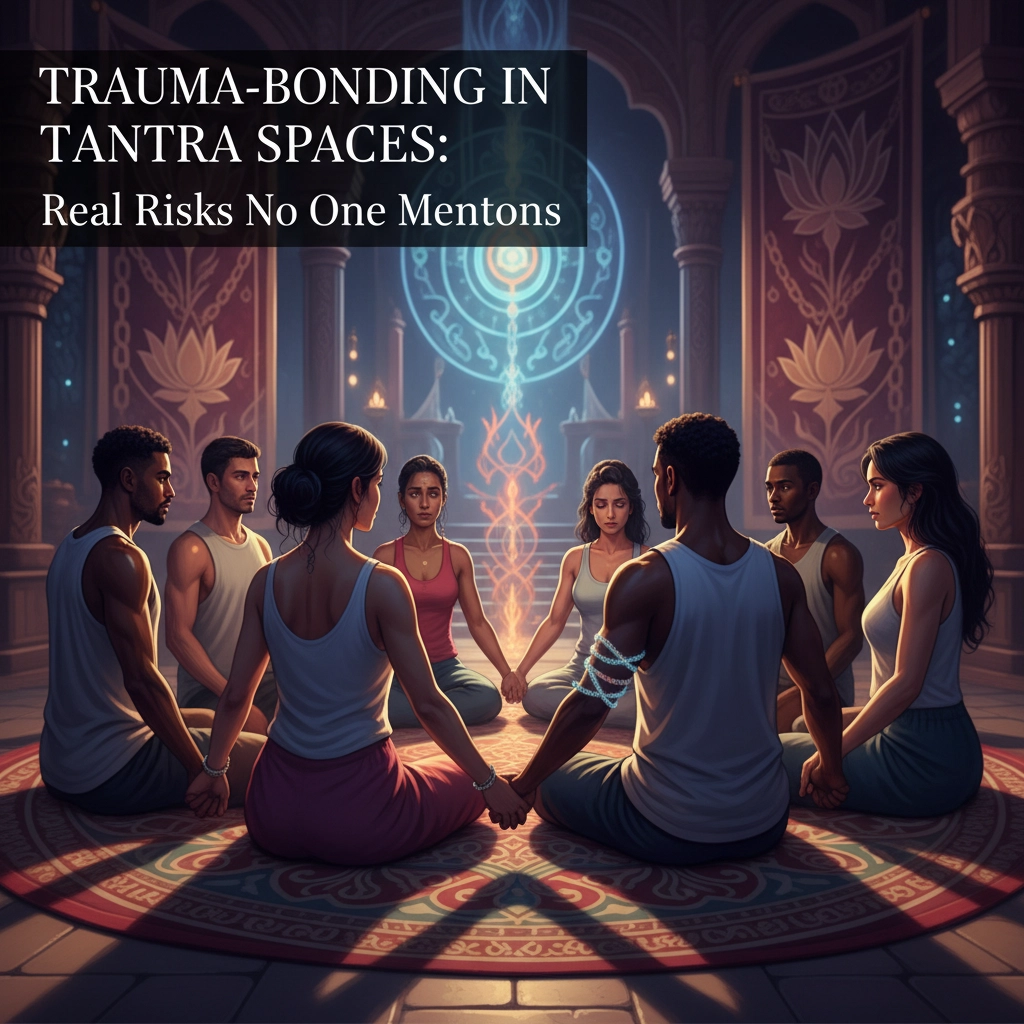Let's talk about something most tantra teachers won't touch with a ten-foot pole: trauma bonding. Yeah, it's uncomfortable. Yeah, it's messy. But if we're serious about creating safe healing spaces, we need to get real about this.
Most people think trauma bonding only happens in obviously abusive relationships. The truth? It can develop in any space where power dynamics, emotional intensity, and vulnerability collide. Tantra spaces check all those boxes.
What Is Trauma Bonding, Really?
Trauma bonding isn't just "getting attached to someone who hurt you." It's a specific psychological process where your nervous system gets addicted to the cycle of pain and relief, criticism and praise, fear and euphoria.
Here's how it works: Someone breaks you down (through criticism, boundary violations, or emotional manipulation), then builds you back up (with affection, validation, or "special" attention). Your brain starts craving both parts of this cycle. The relief feels so intense after the pain that you become psychologically dependent on the person causing both.

In traditional abusive relationships, this looks like verbal attacks followed by love bombing. In spiritual spaces? It's more subtle. Think harsh "truth-telling" followed by profound insights, or boundary violations justified as "breaking through resistance," then deep intimacy.
Why Tantra Spaces Are Vulnerable to This Dynamic
Tantra work involves everything that makes trauma bonding possible:
Extreme Vulnerability: You're often naked, emotional, or in altered states. Your usual defenses are down.
Power Imbalances: Teachers hold authority, supposed wisdom, and often control the group dynamic.
Intense Experiences: Breathwork, energy practices, and bodywork can create profound emotional states. When someone guides you through these, you naturally associate them with the breakthrough feelings.
Isolation from Reality: Multi-day workshops, retreat settings, or insular communities can separate you from outside perspectives.
Sacred Justification: Any concern you raise gets labeled as "resistance," "ego," or "not surrendering to the process."
The most dangerous part? All of these elements can also create genuine healing. That's what makes spotting the difference so tricky.
The Guru-Student Trap
This is where things get really messy. Traditional tantric lineages do involve surrender to a teacher. But authentic surrender happens within clear, consistent boundaries – not through manipulation.
Red flag guru behaviors include:
- Claiming to be your only path to enlightenment
- Insisting their methods are the "real" tantra while everything else is fake
- Using your trauma history against you ("Your resistance to this practice shows how wounded you are")
- Creating financial dependency or isolating you from other teachers
- Sexualizing the student-teacher relationship under spiritual pretenses

Here's what authentic teaching looks like: Teachers acknowledge their limitations. They encourage you to have other teachers, therapists, or mentors. They don't claim ownership over your spiritual progress. They maintain professional boundaries even within intimate practices.
How Trauma Bonding Shows Up in Practice
Maybe your teacher pushes your boundaries during bodywork, then gives you the most profound spiritual insight you've ever had. Your nervous system links the violation with the breakthrough.
Or perhaps they publicly call out your "patterns" in front of the group (humiliation), then privately tell you how proud they are of your growth (elevation). You start craving both the callout and the private praise.
Sometimes it's financial: They create urgency around expensive trainings ("This is your moment – don't let fear hold you back"), then offer you special payment plans or scholarships that make you feel chosen.
The common thread? Your emotional state becomes dependent on their approval, their methods, their presence.
The Biochemistry Behind It
When we experience intense emotional swings – from fear to relief, from shame to acceptance – our brains release powerful neurochemical cocktails. Stress hormones like cortisol and adrenaline during the "breaking down" phase, followed by bonding chemicals like oxytocin during the "building up" phase.
This creates what researchers call "intermittent reinforcement" – the most addictive reward schedule known to psychology. You never know when the next high is coming, so you stay engaged, hoping, trying to recreate that peak experience.

In healthy tantra work, these chemical responses happen within safety and choice. In trauma bonding situations, they happen through manipulation and coercion.
Spotting the Warning Signs
Your body often knows before your mind does. Pay attention to:
Physical Symptoms: Anxiety when thinking about disappointing the teacher, racing heart before classes, exhaustion that seems disproportionate to the physical practice.
Thought Patterns: Obsessing about what the teacher thinks of you, comparing yourself constantly to other students, feeling like this teacher/method is your only hope.
Behavioral Changes: Isolating from friends who question the practice, spending money you don't have on workshops, neglecting other areas of your life.
Emotional Rollercoasters: Extreme highs after classes followed by crashes, feeling emotionally dependent on the teacher's approval.
Most importantly: If you can't imagine leaving or taking a break without feeling panic, that's a red flag.
Breaking Free (Or Not Getting Caught)
First, understand that trauma bonding isn't a character flaw. It's a survival mechanism. Your nervous system learned to find safety in chaos because that's what was available.
Create Outside Anchors: Maintain relationships and activities outside the tantra space. Have friends who don't do this work. Keep seeing other therapists, teachers, or healers.
Trust Your Gut: If something feels off, it probably is. Authentic teachers welcome questions, encourage second opinions, and respect your pace.
Financial Boundaries: Never go into debt for spiritual teachings. Legitimate teachers offer sliding scales or payment plans without emotional manipulation.

Regular Reality Checks: Ask trusted friends about changes they've noticed in you. Sometimes we can't see our own patterns.
Slow Integration: Real transformation happens slowly. Be suspicious of anyone pushing you to make major life changes quickly.
The Healing Paradox
Here's the tricky part: Some level of attachment is normal and even helpful in healing relationships. The difference is whether that attachment supports your growth or stunts it.
Healthy attachment in tantra work feels expansive. You feel more capable, more connected to yourself and others, more able to trust your own judgment. You can disagree with your teacher without panic.
Trauma bonding feels contractive. You feel smaller, more dependent, less able to trust yourself. Disagreeing with the teacher feels impossible or terrifying.
Moving Forward
The goal isn't to avoid intensity or vulnerability in spiritual practice. The goal is to ensure they happen within genuine safety and choice.
If you think you might be in a trauma bond with a teacher or group:
- Reach out to friends or family outside the community
- Consider working with a trauma-informed therapist
- Take a break from the practice to get perspective
- Research the teacher's background and other students' experiences
- Trust that real transformation doesn't require sacrificing your autonomy

Remember: Authentic tantra is about embodying your own divine nature, not surrendering it to someone else. Any teaching that diminishes your capacity for discernment isn't serving your highest good.
The silence around these dynamics needs to end. By talking openly about trauma bonding in spiritual spaces, we can create communities that truly support healing – not just intense experiences that masquerade as growth.
Your spiritual journey belongs to you. Don't let anyone convince you otherwise.



